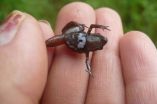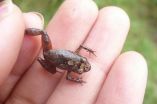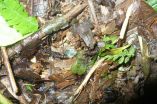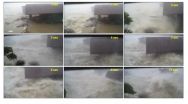Dark and marked: Strikingly colored new fleshbelly frog from the Andean cloud forest
2015-08-06
(Press-News.org) Carrying itself around with a dark brown mask on its face and a broad shapeless white mark on its chest and belly, a frog had been jumping across the Peruvian cloud forests of the Andes unrecognised by the scientific world. Now, this visibly distinguishable species has been picked up by Dr. Catenazzi of Southern Illinois University and his team from its likely only locality, a cloud forest near Cusco in Peru, at 2350 m elevation by Drs. Catenazzi, Uscapi and May. Their research is published in the open-access journal ZooKeys.
The new fleshbelly frog species, called N. madreselva, was discovered by Peruvian researcher Vanessa Uscapi in January 2011 amid leaf litter in the humid montane forest of the Andes. Locally abundant and active during the day, the leaping amphibian was found to be small of size and leading a predominantly terrestrial life. It is likely that the new species has restricted distribution, inhabiting the upper watersheds in the valleys adjacent to the locality where it has been discovered.
The name "madreselva", which translates to "mother jungle" from Spanish, honours the efforts of local conservation initiatives, such as the local ecotourism lodge Madre Selva and the ecological project Sircadia, that aim at protecting the delicate and biologically rich montane forest ecosystems in the region. The new frog is locally abundant in parts of the forest that are protected from logging.
Described by the authors as "striking", the colouration is what visibly differentiates the new frog species from its relatives. Most noticeably, it stands out with the wide irregularly shaped white mark on black background all across, stretching from the creature's chest down to its belly. A brown splash on its head forms a distinguishable dark facial mask.
Because of the frog's limited habitat, the scientists fear that the species is threatened by a large number of risks, including deforestation, diseases and the agricultural activities in the region. However, as for the moment, the frog has been proposed by the researchers to be classified as "Data Deficient" in the IUCN Red List, until new data regarding its distribution become available.
Being often neglected by explorers, small amphibian species like this fleshbelly frog are at high risk of extinction, claim the authors. "It is therefore imperative to document the highly endemic amphibian faunas of wet montane Andean forests as a first step towards designing
a network of natural reserves that maximizes protection of amphibian biodiversity," they insist.
INFORMATION:
Original source:
Catenazzi A, Uscapi V, von May R (2015) A new species of Noblella (Amphibia, Anura, Craugastoridae) from the humid montane forests of Cusco, Peru. ZooKeys 516: 71-84. doi: 10.3897/zookeys.516.9776
ELSE PRESS RELEASES FROM THIS DATE:
2015-08-06
Researchers from the International Research Institute of Disaster Science (IRIDeS) at Tohoku University in Sendai, Japan, have been looking into how tsunami-type waves can originate from massive storm systems, independent of earthquakes or landslides.
According to Volker Roeber and Jeremy D. Bricker, massive storm systems can be the cause of devastating tsunami-type waves. It happened during Typhoon Haiyan, which struck the Philippines in November 2013. Typhoon Haiyan was one of the strongest typhoons ever recorded, causing more than 6,000 casualties.
A development ...
2015-08-06
People who recognise they are overweight or obese are more likely to put on weight than those who are unaware that they may be heavier than doctors would advise, according to research by the University of Liverpool.
In a study, published in the International Journal of Obesity, researchers looked at the lives of 14,000 adults in the US and the UK through data captured in three studies: the US National Longitudinal Study of Adolescent to Adult Health, the UK National Child Development Study and Midlife in the United States.
They analysed data from time periods after ...
2015-08-06
Lack of microinvaginations in the cell membrane, caveolae, can cause serious diseases such as lipodystrophy and muscular dystrophy. Researchers at Lund University in Sweden have now discovered a "main switch" that regulates the formation of these invaginations.
Many cells in the body are equipped with small microinvaginations in the cell membrane called caveolae. They are important for the cell's ability to take up molecules and particles from the cell surface into the cell. If this doesn't work, the function of the cell is disturbed, resulting in diseases. Having too ...
2015-08-06
New camera technology that reveals the world through the eyes of animals has been developed by University of Exeter researchers. The details are published today in the journal Methods in Ecology and Evolution.
The software, which converts digital photos to animal vision, can be used to analyse colours and patterns and is particularly useful for the study of animal and plant signalling, camouflage and animal predation, but could also prove useful for anyone wanting to measure colours accurately and objectively.
The software has already been used by the Sensory Ecology ...
2015-08-06
Dasabuvir (trade name Exviera) and the fixed-dose drug combination ombitasvir/paritaprevir/ritonavir (trade name Viekirax) have been available since January 2015 for the treatment of adults with chronic hepatitis C infection. The German Institute for Quality and Efficiency in Health Care (IQWiG) had examined their added benefit in a dossier assessment completed in April 2015.
In an addendum, the Institute now assessed study data subsequently submitted by the drug manufacturer in the commenting procedure. According to the findings, the results of an indirect comparison ...
2015-08-06
Why some planets, like Saturn or Jupiter, have their rings, while others like, the Earth or Mars do not? It turned out that "the size does not matter" -- not only giants as Saturn possess the rings, but even tiny asteroids do: According to the recent discovery of the Spitzer Space Telescope, the remote asteroid Chariklo, which is only 260 km in diameter, also has rings.
A natural answer may be the following: Occasionally, in a far past, some planets had much more material in their vicinity then the other ones. The material was in a form of dust. Dust particles merged ...
2015-08-06
UC Davis study should help guide patients and their oncologists
(SACRAMENTO, Calif.) -- Combing data collected on thousands of California ovarian cancer patients, UC Davis researchers have determined that almost one-third survived at least 10 years after diagnosis.
The unprecedented findings upend the notion that women diagnosed with cancer of the ovary always face a poor chance of survival. In fact, while the study confirmed earlier findings on characteristics associated with ovarian cancer survival -- younger age, earlier stage and lower grade tumors at diagnosis ...
2015-08-06
The dull black plastic of the device on Joshua Pearce's desk belies its usefulness. Pearce picks up the box, which has a switch on the side and a small opening on top. A handful of vials sit in a bag nearby, and each would fit snugly in the opening. The set-up seems generic, even bland, except that it could radically change how we deal with water quality issues.
Pearce, who has a joint appointment as an associate professor of materials science and engineering as well as electrical and computer engineering, runs an open sustainability technology lab at Michigan Technological ...
2015-08-06
COLLEGE STATION - Woody plant encroachment is one of the biggest challenges facing rangelands worldwide, but it consistently has been under-measured and poorly understood, said a Texas A&M AgriLife Research scientist in College Station.
Dr. Matthew Berg, an AgriLife Research postdoctoral research associate in the Texas A&M department of ecosystem and science management, is trying to change both the understanding and measurement with his latest study, which was captured in the July issue of the Rangeland Ecology and Management publication, http://bit.ly/1JK8JhU.
Berg ...
2015-08-06
Accurately forecasting future electricity needs is tricky, with sudden weather changes and other variables impacting projections minute by minute. Errors can have grave repercussions, from blackouts to high market costs. Now, a new forecasting tool that delivers up to a 50-percent increase in accuracy and the potential to save millions in wasted energy costs has been developed by researchers at the Department of Energy's Pacific Northwest National Laboratory.
Performance of the tool, called the Power Model Integrator, was tested against five commonly used forecasting ...
LAST 30 PRESS RELEASES:
[Press-News.org] Dark and marked: Strikingly colored new fleshbelly frog from the Andean cloud forest







